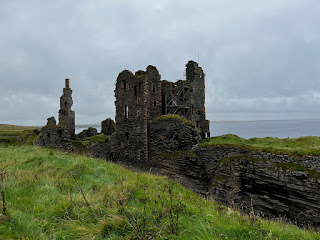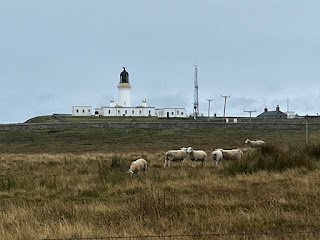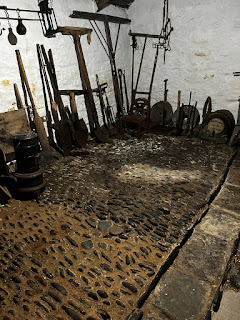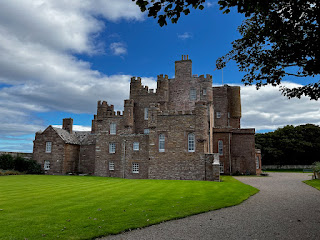As promised, we are continuing our NC500 adventures, this time concentrating on the northeast section. We are staying in a B&B about 20 miles south, in a village called Spittal. Actually, I can't say that one can even call it a village, since it consists of only a few houses. But the location was perfect for our means, and after a lovely breakfast, we hopped right onto the A9 and began our journey today by heading first to John O'Groats.
It was just a very quick stop before we got back onto the road to head east to the Duncansby lighthouse.
This was far easier to reach than the Stoer Lighthouse on the opposite side of the country and we were there in no time at all. The lighthouse itself cannot be toured, but it certainly made a lovely photo.
We had come to see the stacks! So we headed up the trail (a relatively easy one to spot in comparison with the Stoer adventure.), and I was surprised to see the tops of the stacks so soon. That sight was certainly welcomed, but before we reached the point of unobstructed views, we passed The Geo of Sclaites, a deep chasm into the cliffside
We spotted all kinds of birds nesting in the levels imbedded into the rock.
After walking just a short distance more, the stacks came into full view.
I'd never seen anything like this before and they really are quite amazing!
The return walk led to some beautiful views in the opposite direction.
And the sun reappeared, adding a lovely glow to the cliffs.
Just before the car park, at the top of the hill behind the lighthouse, stands a triangulation pillar that was erected in 1952.
We had no idea what this was, and two local men who were passing by were kind enough to give us an explanation.
This pillar played an instrumental part of the 1935 Ordnance Survey, which was designed to complete an accurate data point for mapping. The base was made extra sturdy in order to hold a theodolite absolutely level. This way measurements could be made between pillars to establish height and distance, thereby adding data to the National Grid. The men mentioned hat similar structures stand in various places all over Scotland, and they were used for map making and ordnance survey maps, of course.
We found that to be quite fascinating and wondered if we might have seen some elsewhere, without knowing. We both decided that in the future, we would keep our eyes peeled for others while on our travels.
We then headed in the car, west, to check out the Castle Mey.
This castle was actually a summer home to the Queen Mother. She purchased it for herself, after King George died. She had been visiting friends in the area, desperately mourning the loss to her husband, when someone noted that the derelict castle was up for sale. She returned to London and was encouraged by Winston Churchill to purchase the house as a distraction. At the time of purchase, the roof was on the verge of collapsing and there was no electricity or running water.
It took three years to complete the repairs to the satisfaction of the Queen Mother, and she then began making visits every August and October, continuing until the age of 101.
We were able to tour the house, but no photos are permitted inside. We entered with 3 other couples and found ourselves being entertained by a female guide inside the door.
The woman was the great granddaughter of one of the original owners of the castle, so she certainly had strong ties to the place. But, what was even more fascinating was that her father had been hired as estate manager by the Queen Mother herself shortly after she bought the property. The lands include a farm, and she wanted to continue the upkeep.
This man, the manager, died, and the job passed onto the guide's husband. She and her husband lived on a house on the estate, and she had two boys. When they were teenagers, the husband/father died.
The guide went on to tell us how frightened she had been at the time, because she was certain that the Queen Mother would not want a farm agent that was a teenage boy. She fretted for months until the Queen Mother finally made her annual visit.
The first thing that the Queen Mother did, was to tell the teenage boys, that she had watched them in the fields, and knew their capability. She wanted them to act as co-agents. They agreed, and the family was permitted to maintain the house on the grounds.
She went on to say that the Queen Mother would often amble down to her house, and together they would watch horce racing on the television. Sounds like it was great fun for both!
The Queen Mother continued to visit her beloved Castle Mey until the age of 101, which had been her last time at her castle. But it has passed down to her grandson, King Charles, who only just visited for a holiday himself last month. Many had speculated that he would never visit again, but he showed up in August, just as his grandmama did for nearly 50 years. Fortunately, he was out of residence by the time we arrived, or we would have missed viewing all of the interesting artifacts in the interior of the castle.
On the grounds near the castle stands a walled garden which is filled with beautiful blossoms as well as herbs and plants that are used in the castle kitchen. Walking around them was a real delight.
We treated ourselves to our favorite tea time treat: Scones with clotted cream and jam.
Not only was it tasty, but the view made the perfect backdrop for our adventure.
With our tummies full, we hopped back into the car and headed to Dunnet Head.
This is the official northernly point of the Scotland mainland.
A beautiful lighthouse stands along the shore of the water at the head.
There are many birds who nest in the cliffs, and we were entertained by watching them swoop in and out of the cliffs. Had it been just a month ago, we would have seen Puffins. But they are long gone now.
And sometime within an hour, the outdoor temperatures dropped to what I would consider normal, so we pulled out the fleece and knitwear. No complaints here!
We walked the hill to the elevation where we could have a 360 degree view, and what did I spot? A triangulation pillar!
When I mentioned that we should seek them out, I never anticipated finding one so soon! That was certainly exciting!
That concluded our northern adventure, and we decided to stop in Thurso, at the Tesco, to pick up something that could easily be heated up in a microwave, for our dinner. Yesterday, when we checked into our B&B, I was quite surprised to find that we were in the annex, which was a separate little structure, complete with a living room an kitchenette in addition to the bedroom.
So, we decided to have our own cozy dinner in house rather than drive to a restaurant as there is nothing nearby within walking distance. We found some delicious options and enjoyed a Scottish Cottage Pie, which consisted of a rich beef topped with a potato mash, and I chose Spinach Lasagna. We added a veggie mix to complete our dinner. And, for dessert, we each enjoyed a mini Cherry Almond Traybake.
A lovely, relaxing meal with no hassle.
Marty had discovered the amazing gardens in the back of the B&B, so I went out to see for myself, and was amazed at the vastness of the grounds, as well as the stunning beauty and variety of the blooms. Here are some photos for you to enjoy:
Quite stunning, aren't they?
We've had a lovely, quiet stay here at the Auld Post Office B&B, and it's location was extremely convenient for our needs. Tomorrow we head out to make the trek along the eastern side of the NC500. I see that rain is in the forecast with much cooler temperatures, but no worries.....we're up for the adventure!
Until tomorrow....


























































